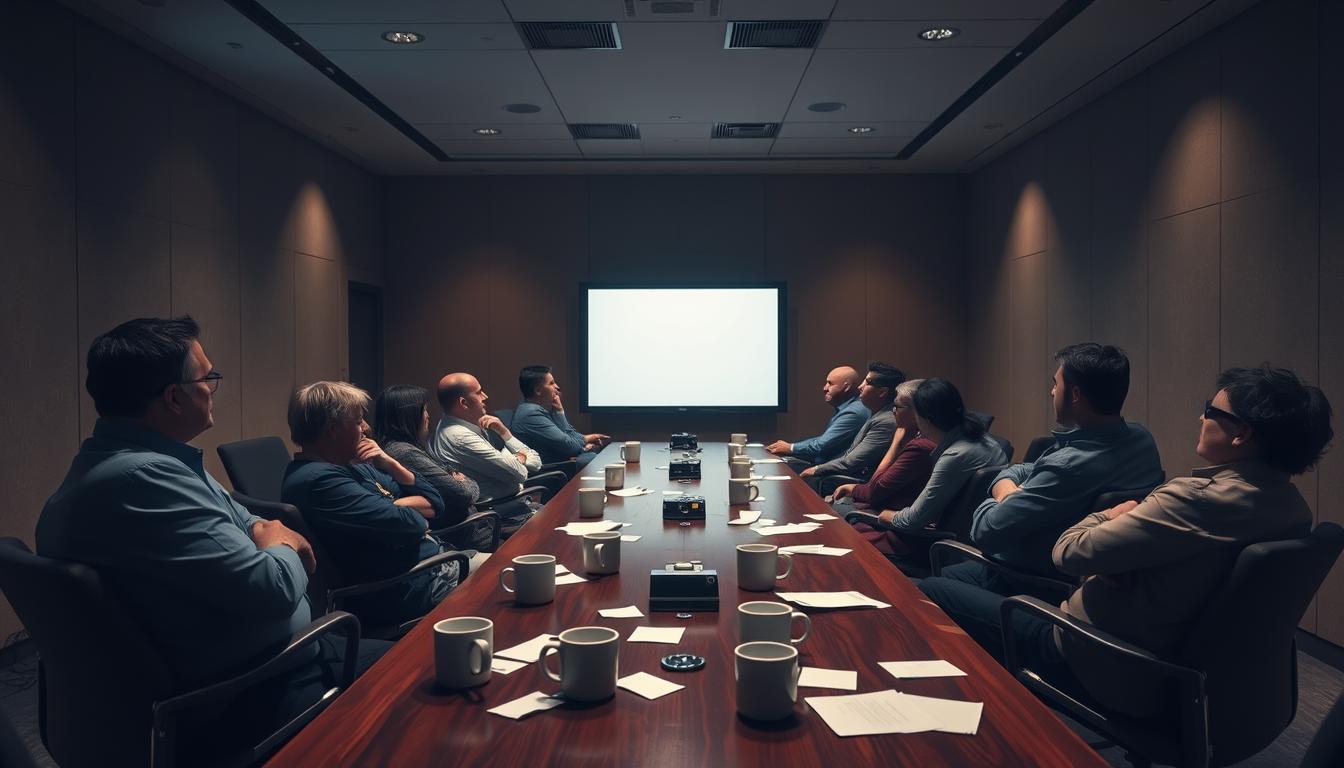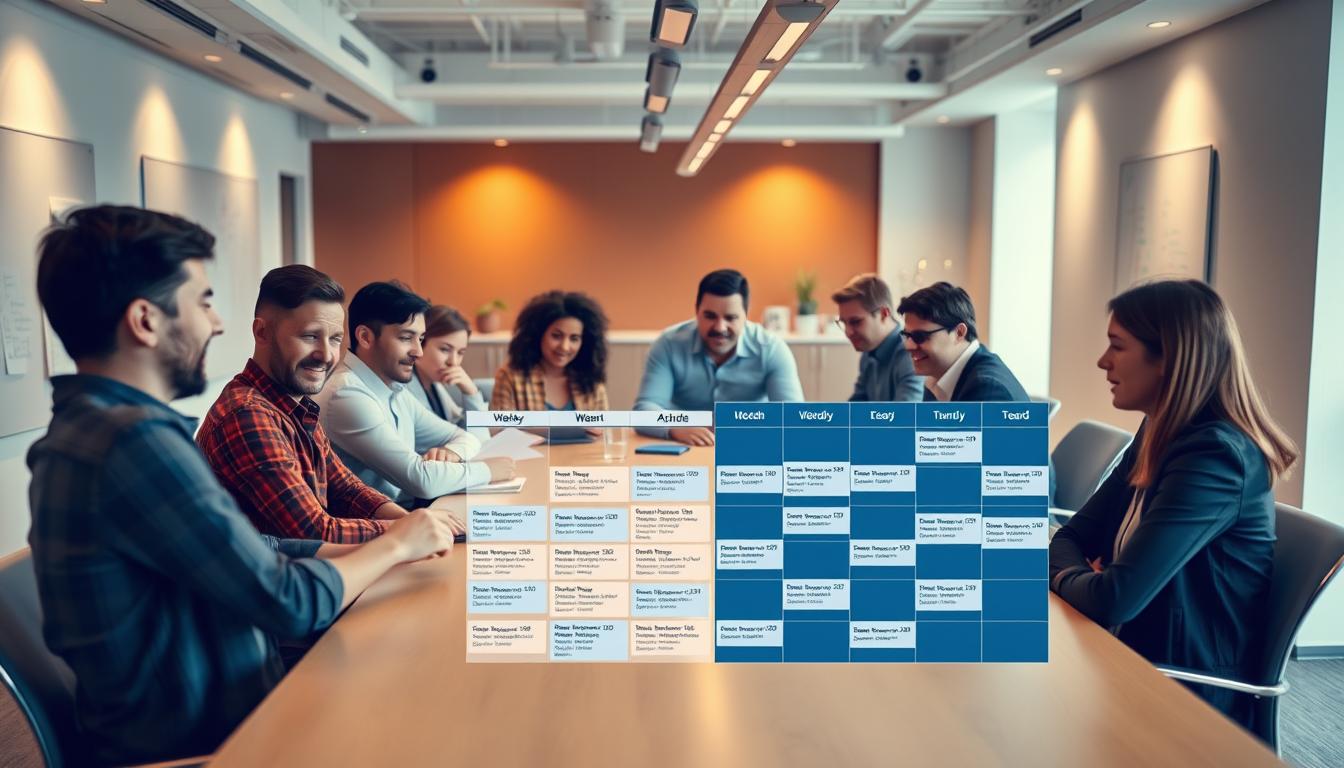In today’s busy work world, too much time is lost in meetings. Organizations aim to make meetings more productive and worth the time. This article shares tips to make meetings better and more effective. By using these ideas, teams can zero in on important tasks. This makes every meeting count and truly useful.
The True Cost of Wasting Time in Meetings
Meetings are key for teamwork but can really waste resources and productivity. It’s vital for organizations to understand how lost productivity impacts them. They also need to figure out the real costs of inefficient meetings.
Understanding Productivity Loss
Meetings without a clear purpose can lead to wasted time. Up to 47% of employees feel meetings can be a waste. This shows a big problem in how workplaces communicate.
Unproductive meetings not only lower morale but also increase costs. For example, a weekly meeting that lasts for an hour and has ten people can cost over $20,000 a year. A well-organized meeting, however, can reduce these losses and make better use of time.
Calculating Meeting Costs
To figure out the true cost of meetings, companies need to look at several things. They should start with how much attendees earn and how long meetings last. This helps stress the need for planning meetings well.
By analyzing meeting costs, companies can cut unnecessary meetings and save a lot of money. Knowing the real cost of meetings can change how companies manage their time and money.
Why Meetings Can Be Unproductive
Many businesses struggle with meetings that don’t produce results. This leads to employee frustration and lower work efficiency. Understanding why meetings fail is key. The topics discussed, how involved people are, and how long the meeting lasts all impact its success.
Identifying Common Issues
Workers run into several issues during meetings that lower productivity:
- Lack of a focused agenda that leads to unfocused discussions.
- Too many meetings, overwhelming everyone involved.
- Poor participation, with team members not engaging or coming unprepared.
When meetings have these problems, they don’t do much good. They end up wasting precious time and resources.
The Frequency and Length of Meetings
The length of a meeting can make or break its effectiveness. Studies have found that meetings longer than 50 minutes tire participants and make it hard to stay focused. When there are too many meetings, there’s not enough time left for important work. Finding the right balance between meeting time and work time is crucial for keeping things productive.
Strategies to Cut Down on Unnecessary Meetings
Making meetings more efficient can really help a team’s overall productivity. One key strategy is to review all current meetings. This way, you can see which ones can be skipped without causing any issues. Often, a short update or a quick online check-in can take the place of long meetings. This lets everyone focus on what’s most important.
Canceling Non-Essential Meetings
Teams need to regularly check if their meetings are essential. Instead of long talks, a short written update or a quick online chat can work. This saves time and lets everyone concentrate on their main tasks. It helps them focus deeply when they need to.
Implementing a No-Meeting Day
Having one day with no meetings can really change how work feels. It gives everyone a break to solve harder tasks. This boosts productivity and creativity at work. A no-meeting day improves how people feel at work and helps them do better. It encourages smarter time management.
Effective Planning Precedes Effective Meetings
Preparation is key to a successful meeting. It begins with setting up a solid plan. This includes well-thought-out meeting agendas. Agendas act like a roadmap. They show the goals and what’s expected, helping everyone come ready and focused.
The Importance of Written Agendas
Agendas are more than topic lists. They clearly lay out the meeting’s aim and structure. By listing topics to cover, they let team members get their thoughts and items ready beforehand. This keeps talks on point and ensures all voices are heard.
Share Agendas in Advance for Preparation
Sharing agendas early boosts meeting engagement. Getting them in advance lets participants tailor their input to the meeting’s objectives. This approach builds a sense of responsibility. Everyone gets their role, making for more effective meetings.
Setting Clear Objectives for Meetings
Clear objectives make meetings focused and hold everyone accountable. Every meeting should have a clear goal. This goal shapes the talks and choices made.
When people know why they are meeting and what’s expected of them, they work better together.
Defining the Purpose of Each Meeting
Knowing the meeting’s purpose is key for good cooperation. It keeps discussions on track. And stops people from talking about unrelated things.
When everyone knows the meeting’s goals, conversations are more direct. This makes the most of the time spent together.
Aligning Attendees with Agenda Goals
It’s important for everyone to be on the same page with the agenda. Giving people specific roles makes discussions more effective. They know how they can best contribute.
Working together on the agenda lets everyone talk about important issues. This leads to better meetings.
Wasting Time in Meetings: Accountability Matters
When people know they have to be timely and ready for meetings, things run smoothly. Understanding their roles makes attendees take things seriously. This discussion on being punctual can make meetings more effective.
Encouraging Timeliness and Preparedness
Setting clear rules helps meetings succeed. We should ask everyone to be on time and ready. This keeps conversations on track, helping in making good decisions. Asking for a summary of topics before meetings can make them even better.
Promoting Accountability for Action Items
It’s vital to be clear about who needs to do what after a meeting. Going over what everyone agreed to do helps everyone remember their tasks. Having someone check on progress helps in keeping promises. Regularly checking in on tasks makes sure meetings lead to real results.

Innovative Meeting Formats to Boost Engagement
Exploring new ways to meet can make team work better together. Stand-up meetings are short and keep talks on point. These quick meetings help everyone get involved, making sure key points are discussed without wasting time.
Consider Stand-Up Meetings for Efficiency
Stand-up meetings help communicate fast. They create a sense of hurry, making people get straight to the point. This way, meetings are shorter but everyone stays updated and interested.
Leveraging Technology for Virtual Collaboration
Using the latest virtual tools is key when working remotely. Video calls improve how far-apart teams work together. These tools let us talk face-to-face and do activities together, making meetings more lively and effective.
Follow-Up Actions After Meetings
Follow-up actions after meetings are key to making sure decisions are carried out. Meeting recaps are a great tool. They summarize talks, set clear tasks, and keep projects moving forward. This process makes sure everyone knows what they should do next.
Sending Recap Emails for Clarity
After meetings, recap emails help everyone remember what was discussed. They list decisions and what each person needs to do. This keeps teams on track and helps avoid confusion, boosting productivity.
Continuing Accountability Through Regular Check-Ins
Regular check-ins keep everyone accountable for their tasks. They make members feel responsible and allow for progress updates. Having a good tracking system reduces unnecessary future meetings by keeping everyone up to date with their tasks and due dates.
Conclusion
Running efficient meetings is key for any successful organization. Recognizing the cost of wasted time helps improve productivity. It’s important to use meeting time wisely, creating a responsible and time-respectful work culture.
To cut down on needless meeting time, start with clear goals and plan well. Using new meeting styles and focusing on results can boost team performance. Making meetings productive is essential for reaching company goals and keeping employees motivated.
Good time management and avoiding time-wasting habits are crucial. This approach helps businesses overcome hurdles and grasp new chances. This ensures meetings are beneficial to their mission.



